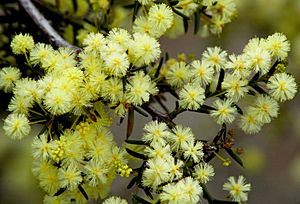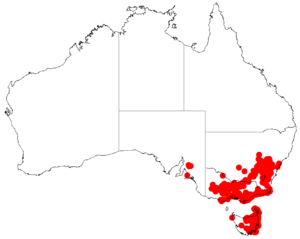Spreading wattle facts for kids
Quick facts for kids Spreading wattle |
|
|---|---|
 |
|
| Scientific classification | |
| Genus: |
Acacia
|
| Species: |
genistifolia
|
 |
|
| Occurrence data from AVH | |
The Acacia genistifolia, often called spreading wattle or early wattle, is a type of Acacia plant. It belongs to the Fabaceae family, which includes peas and beans. This plant is native to southeastern Australia.
Contents
Discovering the Spreading Wattle
The spreading wattle is a small to medium-sized shrub. It can grow up to about 3 meters (10 feet) tall. This plant has special leaf-like structures called phyllodes. These phyllodes are stiff and narrow. They are usually 15 to 30 millimeters long (about 0.6 to 1.2 inches) and end in a sharp point.
Flowers and Seed Pods
The spreading wattle blooms from late summer through spring. Its flowers are cream or pale yellow. They grow in round clusters. These clusters appear where the phyllodes meet the stem, which is called the axil. Each flower cluster usually has 12 to 25 tiny flowers.
After the flowers, the plant grows long, thin seed pods. These pods are 4 to 11 centimeters (about 1.6 to 4.3 inches) long and 4 to 7 millimeters (about 0.16 to 0.28 inches) wide. Inside the pods, the seeds are arranged in a line. Each seed is about 3.5 to 5.5 millimeters long.
Where the Spreading Wattle Grows
This shrub is found only in southeastern Australia. It grows in southeastern New South Wales, eastern Victoria, and eastern Tasmania. You can find it in open forests or areas with heath plants.
Habitat and Location Details
The spreading wattle's home stretches from Dubbo in New South Wales down to the Grampians in Victoria. In Tasmania, it is more common in the northeast, including Bruny and Flinders Islands.
This plant can grow in many different types of soil. It prefers altitudes below 1,000 meters (about 3,300 feet). It is often part of dry sclerophyll forests or heathlands. These are places with tough, leathery-leaved plants that can handle dry conditions.

